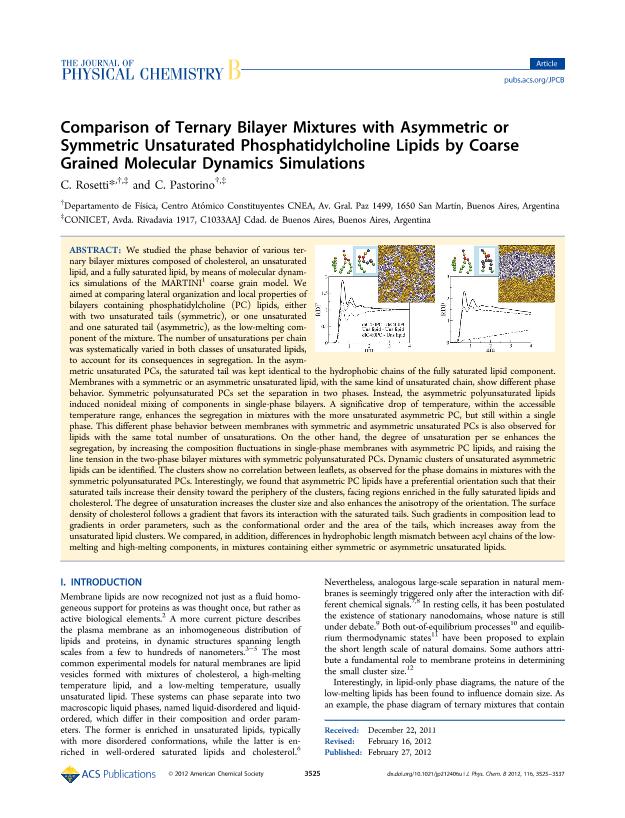Artículo
Comparison of Ternary Bilayer Mixtures with Asymmetric or Symmetric Unsaturated Phosphatidylcholine Lipids by Coarse Grained Molecular Dynamics Simulations
Fecha de publicación:
02/2012
Editorial:
American Chemical Society
Revista:
Journal of Physical Chemistry B
ISSN:
1520-6106
Idioma:
Inglés
Tipo de recurso:
Artículo publicado
Clasificación temática:
Resumen
We studied the phase behavior of various ternary bilayer mixtures composed of cholesterol, an unsaturated lipid, and a fully saturated lipid, by means of molecular dynamics simulations of the MARTINI(1) coarse grain model. We aimed at comparing lateral organization and local properties of bilayers containing phosphatidylcholine (PC) lipids, either with two unsaturated tails (symmetric), or one unsaturated and one saturated tail (asymmetric), as the low-melting component of the mixture. The number of unsaturations per chain was systematically varied in both classes of unsaturated lipids, to account for its consequences in segregation. In the asymmetric unsaturated PCs, the saturated tail was kept identical to the hydrophobic chains of the fully saturated lipid component. Membranes with a symmetric or an asymmetric unsaturated lipid, with the same kind of unsaturated chain, show different phase behavior. Symmetric polyunsaturated PCs set the separation in two phases. Instead, the asymmetric polyunsaturated lipids induced nonideal mixing of components in single-phase bilayers. A significative drop of temperature, within the accessible temperature range, enhances the segregation in mixtures with the more unsaturated asymmetric PC, but still within a single phase. This different phase behavior between membranes with symmetric and asymmetric unsaturated PCs is also observed for lipids with the same total number of unsaturations. On the other hand, the degree of unsaturation per se enhances the segregation, by increasing the composition fluctuations in single-phase membranes with asymmetric PC lipids, and raising the line tension in the two-phase bilayer mixtures with symmetric polyunsaturated PCs. Dynamic clusters of unsaturated asymmetric lipids can be identified. The clusters show no correlation between leaflets, as observed for the phase domains in mixtures with the symmetric polyunsaturated PCs. Interestingly, we found that asymmetric PC lipids have a preferential orientation such that their saturated tails increase their density toward the periphery of the clusters, facing regions enriched in the fully saturated lipids and cholesterol. The degree of unsaturation increases the cluster size and also enhances the anisotropy of the orientation. The surface density of cholesterol follows a gradient that favors its interaction with the saturated tails. Such gradients in composition lead to gradients in order parameters, such as the conformational order and the area of the tails, which increases away from the unsaturated lipid clusters. We compared, in addition, differences in hydrophobic length mismatch between acyl chains of the low-melting and high-melting components, in mixtures containing either symmetric or asymmetric unsaturated lipids.
Archivos asociados
Licencia
Identificadores
Colecciones
Articulos(SEDE CENTRAL)
Articulos de SEDE CENTRAL
Articulos de SEDE CENTRAL
Citación
Rosetti, Carla Mariana; Pastorino, Claudio; Comparison of Ternary Bilayer Mixtures with Asymmetric or Symmetric Unsaturated Phosphatidylcholine Lipids by Coarse Grained Molecular Dynamics Simulations; American Chemical Society; Journal of Physical Chemistry B; 116; 11; 2-2012; 3525-3537
Compartir
Altmétricas




